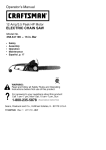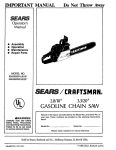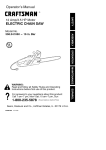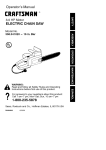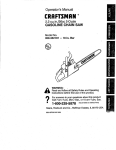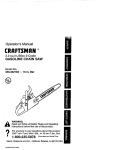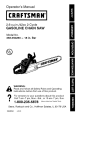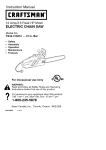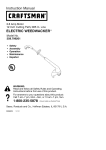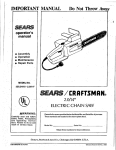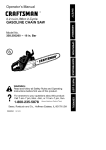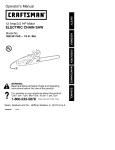Download Craftsman 358.341170 Operator`s manual
Transcript
Operator's Manual I CRRFT$1VlRN°I 12 Amp/3.5 HP Motor ELECTRIC CHAIN SAW Model No. 358.341170 - 16 in. Bar • Safety • Assembly • Operation • Maintenance • EspaSol, p 17 WARNING: Read and follow all Safety Rules and Operating Instructions before first use of this product. For answers Call 7 am-7 to your questions about this product: pm, Mon-Sat; 10 am-7 pm, Sun 1-800-235-5878 Sears, Roebuck 545154163 (Hours and Co., Hoffman Rev. 2 5/24/07 BRW listed are Central Estates, Time) IL 60179 U.S.A. Warranty Safety Rules Assembly Operation Maintenance 2 2 7 7 12 Service and Adjustments Storage Troubleshooting Table Spanish Parts Ordering 14 15 16 17 Back Cover ONE YEAR FULL WARRANTY ON CRAFTSMAN ELECTRIC CHAIN SAW When used and maintained according to the operator's manual, if this product fails due to a defect in material or workmanship within one year from the date of purchase, return it to any Sears store or other Craftsman outlet in the United States for free replacement. This warranty excludes the bar and chain, which are expendable parts that can wear out from normal use in less than one year. This warranty applies for only 30 days from purchase date if this product is used for commercial or rental purposes. This warranty gives you specific legal rights, and you may also have other rights which vary from state to state. Sears, Roebuck and Co., Hoffman Estates, IL 60179 WARNING: When using electric gardening appliances, basic safety precautions must always be followed to reduce the risk of fire, electric shock, and serious injury. Read and follow all instructions. ,_ WARNING: Always disconnect unit from power source when making repairs, adjustments, and when changing accessories and attachments such as saw bar, chain or guards. Because a chain saw is a high-speed woodcutting tool, special precautions must be observed to reduce risk of accidents. Careless or improper use of this tool can cause serious injury. PLAN AHEAD • Restrict the use of your saw to adult users who understand and can follow the safety rules, precautions, and operating instructions found in this manual. • Dress properly. Wear protective gear. Always use steel-toed safety footwear with non-slip soles; snug-fitting clothing; heavy-duty, non-slip gloves; eye protection such as non-fogging, vented goggles or face screen; an approved safety hard hat; and sound barriers (ear plugs or mufflers) to protect your hearing. Regular users should have hearing checked regularly as chain saw noise can damage hearing. Secure hair above shoulder length. Do not wear loose clothing or jewelry; they can get caught in moving parts. Hearing Protection ''_ _ I _-_ Safety Hat Eye Snug Fitting Clothing Safety Protection Heavy Duty Gloves _ Safety Chaps Shoes Keep all parts of your body away from the chain when saw is running. Keep children away. Do not let visitors contact chain saw or extension cord. All visitors should be kept at least 30 feet (10 meters) away from work area. Do not handle or operate a chain saw when you are fatigued, ill, upset, or if you have taken alcohol, drugs, or medication. You must be in good physical condition and mentally alert. If you have any condition that might be aggravated by strenuous work, check with doctor before operating. Watch whatyouaredoing. Usecommon • Nonconforming replacement composense. nents ortheremoval ofsafety devices • Donotstartcutting untilyouhavea maycause damage totheunitand clear workarea, secure footing, and possible injury totheoperator orbyespecially ifyouarefelling atree,a standers. UseonlyCraftsman accesretreat path.Keep work areaclean. sories andreplacement parts asrecOPERATE YOUR SAW SAFELY ommended. Never modify yoursaw. chain sawwithcare. • Donotoperate withonehand. Seri- • Maintain unitsharp andclean forbetter ousinjury totheoperator, helpers, or • Keep andsaferperformance. bystanders mayresult fromoneinstructions forlubricating and handed operation. Achainsawisin- • Follow tended fortwo-handed use. changing accessories. thechain sawfromthepower • Donotoperate sawfromaladder or • Unplug source when notinuse,before servicinatree. ing,andwhen changing accessories • Make surethechain willnotmake such assawchain contact withanyobject whilestarting andattachments, thesaw.Never startthesawwhen andguard. • Check fordamaged parts. Before furtheguide barisinacut. theruseofthechain saw,aguard or • Donotforcechainsaw.Itwilldothe other partthatisdamaged should be jobbetter andsaferattheratefor which itwasintended. carefully checked todetermine thatit willoperate properly andperform its • Donotputpressure onthesaw,esintended function. Check foralignment pecially attheendofthecut.Doing ofmoving parts, binding ofmoving socancause youtolosecontrol parts, breakage ofparts, mounting and when thecutiscompleted. conditions thatmayaffect its • Stopthesawbefore setting itdown. anyother operation. Aguard orother partthatis • Hand carrysawonlywhen motor is damaged should beproperly repaired stopped. Carry thechain sawbythe byaSears Service Center front handle withthesawstopped, fin- orreplaced unless otherwise indicated elsewhere gerofftheswitch, theguide barand sawchain totherear. intheoperator's manual. • When notinuse,chain sawsshould • Usetherighttool,cutwoodonly. bestored inadry,highorlocked-up Don't usechain sawforpurpose not place outofthereach ofchildren. intended; forexample, don'tuse storing saw,unplug andusea chain sawforcutting plastic, mason- • When barsheath orcarrying case. ry,non-wood building materials. • Donotoperate achain sawthatis ELECTRICAL SAFETY damaged, improperly adjusted, or notcompletely andsecurely as_, WARNING: Avoid adangerous sembled. Always replace bar,chain, environment. Toreduce theriskof handguard, orotherparts immedi- electrical shock, donotuseinrain,in atelyiftheybecome damaged, bro- damp orwetlocations, oraround ken,orareotherwise removed. swimming pools, hottubs, etc.Donot • Inspect chain sawcords periodicallyexpose tosnow, rain,orwater toavoid andifdamaged, haverepaired bya thepossibility ofelectrical shock. Do Sears Service Center. nothandle extension cordorplugwith MAINTAIN YOURSAWIN GOOD wethands. WORKING ORDER • Useonlyavoltage supply asshown • Have allchainsawservice peronthenameplate oftheunit. formed byaSears Service Center • Avoid dangerous situations. Donot except theitems listed intheMAINTE- useinthepresence offlammable liqNANCE section ofthismanual. uidsorgases toavoidcreating afire • Make certain sawchain stopsmovorexplosion and/or causing damage ingwhen trigger switch isreleased. tounit. theriskofelectrical shock, • Keep thehandles dryandclean and • Toreduce freefromoilandgrease. thisappliance hasapolarized plug • Keep oilcapandfasteners securely (one blade iswider thantheother) and tightened. willrequire theuseofapolarized ex- tension cord. Theappliance plugwillfit on circuit or outlet to be used. Reintoapolarized extension cordonly ceptacles are available having builtoneway.Iftheplugdoes notfitfully in GFCI protection and may be used intotheextension cord, reverse the for this measure of safety. Inspect plug. Iftheplugstilldoes notfit,obtain chain saw cords periodically and if acorrect polarized extension cord. A damaged, have repaired by a Sears Service Center. polarized extension cord willrequire theuseofapolarized walloutlet. This GUARD AGAINST KICKBACK plugwillfitintothepolarized walloutlet all safety rules to help avoid kickonlyoneway. Ifplugdoes notfitfully Follow and other forces which can result intothewalloutlet, reverse theplug. If back in serious injury. theplugstilldoes notfit,contact a Kickback Path qualified electrician toinstall theproper walloutlet. Donotchange theequipment plug, extension cordreceptacle, orextension cordpluginanyway. • Toreduce riskofelectrical shock, use extension cords specifically marked as suitable foroutdoor appliances. The electrical rating ofthecordmust notbe Avoid Obstructions lessthantherating oftheunit.The cordmust bemarked withsuffix "W-A" (inCanada, '_/"). Use a polarized • • • • • • cord. Make sure your extension cord is in good condition. Inspect extension cord before use and replace if damaged. Do not use a damaged cord. Cord insulation must be intact with no cracks or deterioration. Plug connectors must be undamaged. An undersized extension cord will cause a drop in line voltage resulting in loss of power and overheating. If in doubt, use the next heavier gauge. The lower the gauge number, the heavier the cord (see SELECT AN EXTENSION CORD in the OPERATION section). Do not use multiple cords. Do not abuse cord. Never carry the unit by the extension cord or yank extension cord to disconnect unit. Secure extension cord to power cord to prevent disconnection from unit. Do not use the unit if the switch does not turn the unit on and off properly, or if the lock-out does not work. Repairs to the switch must be made by a Sears Service Center. Keep extension cord clear of operator and obstacles at all times. Position cord so that it will not be caught on branches. Do not expose cords to heat, oil, water, or sharp edges. To avoid the possibility of electric shock, avoid body contact with any grounded conductor, such as metal fences or pipes. Ground Fault Circuit Interrupter (GFCI) protection should be provided Clear The Working Area ,t% A all.WARNING: Avoid kickback which can result in serious injury. Kickback is the backward, upward or sudden forward motion of the guide bar occurring when the saw chain near the upper tip of the guide bar contacts any object such as a log or branch, or when the wood closes in and pinches the saw chain in the cut. Contacting a foreign object in the wood can also result in loss of chain saw control. • Rotational Kickback can occur when the moving chain contacts an object at the upper tip of the guide bar. This contact can cause the chain to dig into the object, which stops the chain for an instant. The result is a lightning fast, reverse reaction which kicks the guide bar up and back toward the operator. • Pinch-Kickback can occur when the the wood closes in and pinches the moving saw chain in the cut along the top of the guide bar and the saw chain is suddenly stopped. This sudden stopping of the chain results in a reversal of the chain force used to cut wood and causes the saw to move in the opposite direction of the chain rotation. The saw is driven straight back toward the operator. • PuB-In canoccur when themoving • Donottwistthesawasthebaris fromanundercut when chain contacts aforeign object inthe withdrawn wood inthecutalong thebottom of bucking. AvoidPuB-In: theguide barandthesawchainis suddenly stopped. Thissudden stop- • Always begin cutting withthesawat pingpullsthesawforward andaway fullspeed andthesawhousing fromtheoperator andcould easily against wood. cause theoperator tolosecontrol of • Usewedges made ofplastic or thesaw. wood. Never usemetal toholdthe REDUCE THECHANCE OF cutopen. KICKBACK MAINTAIN CONTROL: • Recognize thatkickback canhappen. Withabasic understanding ofkickback, youcanreduce theelement of Stand totheleftofthes_ surprise which contributes toaccidents. • Never letthemoving chain contact Thumb on Y""xj I::_;_W anyobject atthetipoftheguide bar. underside ! _'_ • Keep working areafreefromobstrucof handlebar kt_(_ tionssuchasother trees, branches, rocks, fences, stumps, etc.Eliminate oravoidanyobstruction thatyour sawchain couldhitwhile cutting. Never reverse • When cutting abranch, donotletthe hand positions guide barcontact another branch or other objects around it. • Keep sawchain sharp andproperly tensioned. Aloose ordullchain can increase thechance ofkickback. _ Elbow Follow manufacturer's chain sharp_:_l locked ening andmaintenance instructions. Check tension atregular intervals, • A good, firm grip on the saw with butnever withengine running. Make both hands will help you maintain surebarclamp nutsaresecurely control. Don't let go. Grip the rear tightened. handle with your right hand whether • Begin andcontinue cutting atfull you are right or left handed. Wrap the speed. Ifthechain ismoving ata fingers of your left hand over and slower speed, thereisgreater around the front handlebar, and your left thumb under the front handlebar. chance ofkickback occurring. • Useextreme caution when re-enter- Keep your left arm straight with the elbow locked. ingacut. • Donotattempt cutsstarting withthe • Position your left hand on the front tipofthebar(plunge cuts). handlebar so it is in a straight line • Watch forshifting logsorotherobwith your right hand on the rear hanjectsthatcouldclose acutandpinch dle when making bucking cuts. orfallontochain. Stand slightly to the left side of the • Usethespecified Reduced-Kickback saw to keep your body from being in Guide BarandLowKickback Chain. a direct line with the cutting chain. AvoidPinch-Kickback: • Stand with your weight evenly balanced on both feet. • Beextremely aware ofsituations or obstructions thatcancause material • Do not overreach. You could be drawn or thrown off balance and lose control. topinch thetopoforotherwise stop thechain. • Do not cut above shoulder height. It is difficult to maintain control of saw • Donotcutmore thanonelogata time. above shoulder height. KICKBACK SAFETY FEATURES ,_ WARNING: The following features are included on your saw to help reduce hazard of kickback; however, such features will not totally eliminate this danger. Do not rely only on safety devices. Follow all safety rules to help avoid kickback and other forces which can result in serious injury. • Hand Guard: designed to reduce the chance of your left hand contacting the chain if your hand slips offthe front handlebar. • Position of front and rear handlebars: designed with distance between handles and "in-line" with each other. The spread and "in-line" position of the hands provided by this design work together to give balance and resistance in controlling the pivot of the saw back toward the operator if kickback occurs. • Reduced-Kickback Guide Bar: designed with a small radius tip which reduces the size of the kickback danger zone on the bar tip. This type bar has been demonstrated to significantly reduce the number and seriousness of kickbacks when tested in accordance with ANSI B175.1. Tip Guide Bar _,_, Small Large Radius I Tip Guide Bar Radius "_ • Low Kickback Chain has met kickback performance requirements when tested on the representative sample of these chain saws specified in ANSI B175.1. Low Kickback ._,_ Chain Contoured Depth Gauge Deflects Kickback Force And Allows Guard Wood Link To Elongated Gradually Ride Into Cutter SAFETY NOTICE: Exposure to vibrations through prolonged use of hand tools could cause blood vessel or nerve damage in the fingers, hands, and joints of people prone to circulation disorders or abnormal swelling. Prolonged use in cold weather has been linked to blood vessel damage in otherwise healthy people. If symptoms occur such as numbness, pain, loss of strength, change in skin color or texture, or loss of feeling in the fingers, hands, or joints, discontinue the use of this tool and seek medical attention. An anti-vibration system does not guarantee the avoidance of these problems. Users who operate power tools on a continual and regular basis must closely monitor their physical condition and the condition of this tool. DOUBLE INSULATION CONSTRUCTION This unit is double insulated to help protect against electric shock. Double insulation construction consists of two separate "layers" of electrical insulation instead of grounding. Tools and appliances built with this insulation system are not intended to be grounded. No grounding means is provided on this unit, nor should a means of grounding be added to this unit. As a result, the extension cord used with this unit can be plugged into any polarized 120 volt electrical outlet. Safety precautions must be observed when operating any electrical tool. The double insulation system only provides added protection against injury resulting from an internal electrical insulation failure. WARNING: All electrical repairs to this unit, including housing, switch, motor, etc., must be diagnosed and repaired by qualified service personnel. Replacement parts for a double insulated appliance must be identical to the parts they replace. A double insulated appliance is marked with the words "double insulation" or "double insulated". The symbol [] (square within a square) may also be marked on the appliance. Failure to have the unit repaired by Sears service personnel can cause the double insulation construction to become ineffective and result in serious injury. STANDARDS: This product is listed by Underwriters Laboratories, Inc. in accordance with U L Standard 1662 and ANSI B175.1. ANSI B175.1-2000 "American National Standard for Powered Tools - Safety Requirements". SAVE THESEINSTRUCTIONS CARTON CONTENTS Check carton contents against the following list. Model 358,341170 • Chain Saw (fully assembled) • Bar Sheath Examine parts for damage. Do not use damaged parts. NOTE: If you need assistance or find that parts are missing or damaged, please call 1-800-235-5878 ASSEMBLY Your unit is fully assembled; no assembly is required. KNOW YOUR CHAIN SAW READ THIS OPERATOR'S MANUAL AND SAFETY RULES BEFORE OPERATING YOUR CHAIN SAW. Compare the illustrations with your unit to familiarize yourself with the location of the various controls and adjustments. Save this manual for future reference. Bar Oil C._ /._/_ ..... _ _:_/_ /ngger LOCK-OU[_--_.---"-/"----//_==::E;:::_--" .,_j_ Button ./#_,:_ Power 4,._ Cord " _ TRIGGER _- /_ _ / . _ bw_[cn //-_ \ \ Bar '_' O_llLevel Bar Clamp _ Indicator SWITCH The TRIGGER SWITCH is used to turn on the unit. Squeeze the trigger switch to operate the unit after lock-out button has been pushed forward. Release the trigger to turn the unit off. TRIGGER LOCK-OUT Hand Guard Chain Adjustment Screw / BUTTON The TRIGGER LOCK-OUT button is a control feature designed to prevent the motor from being accidentally started. When the rear handle is gripped in a normal cutting position, the trigger lock-out button can be pushed forward by the thumb, permitting the index finger to squeeze the trigger. It is not necessary to maintain pressure on the trigger lock-out button once the trigger has been engaged. Bar Sprocket Hole BAR OIL CAP The BAR OIL CAP is used to fill the bar oil tank. CHAIN ADJUSTMENT SCREW The CHAIN ADJUSTMENT SCREW is used to adjust the chain tension. POWER CORD The POWER CORD is used to connect the chain saw to an approved extension cord. CHAIN TENSION It is normal for a new chain to stretch during first 30 minutes of operation. You should check your chain tension frequently. Readjust chain after every 15 minutes of operation. See CHECK CHAIN TENSION under the SERVICE AND ADJUSTMENTS section. OPERATING INSTRUCTIONS Use only a voltage supply as specified on your unit. SELECT AN EXTENSION CORD Extension cords are available for this unit at Sears. _,..... Chain MINIMUM WIRE GAUGE RECOMMENDATIONS Volts 120 *American 25 ft. (7.67 M) 16 A.W.G.* Wire Gauge 50 ft. (15.24 M) 16 A.W.G.* 100 ft. (30.48 M) 14 A.W.G.* ATTACH THE EXTENSION CORD TO YOUR CHAIN SAW To prevent disconnection from unit, secure extension cord to power cord as shown in the following illustration. Power Cord r"-""""'- Extension Cord BEFORE STARTING SAW _WARNING: Be sure to read the electrical safety information in the safety rules section of this manual before you begin. If you do not understand the electrical safety information do not attempt to use your unit. Seek help from someone that does understand the information or call the customer assistance help line at 1-800-235-5878. GUIDE BAR AND CHAIN OIL The bar and chain require lubrication. The chain oiler provides lubrication to the chain and guide bar. Be sure to fill the bar oil tank before each cutting session. Lack of oil will quickly ruin the bar and chain. Too little oil will cause overheating shown by smoke coming from the chain and/or discoloration of the bar. For maximum guide bar and chain life, we recommend you use Craftsman chain saw bar oil. If Craftsman bar oil is not available, you may use a good grade SAE 30 oil until you are able to obtain Craftsman brand. Use a funnel to fill the tank. Replace oil cap securely. Check oil level after every 15 minutes of operation. Oil level can be monitored by viewing the oil level indicator (see illustration in KNOW YOUR CHAIN SAW section). STOPPING YOUR UNIT Release the trigger switch. • If motor does not stop, disconnect the extension cord. Discontinue use of unit until repaired by a Sears Service Center. STARTING YOUR UNIT 1. Connect the saw to a power source using the proper size extension cord (see SELECT AN EXTENSION CORD in the OPERATION section). 2. Grip both handles firmly. 3. Push and hold the trigger lock-out button with your right hand thumb. 4. Squeeze and hold the trigger switch. OPERATING TIPS • Check chain tension before first use and after 1 minute of operation. See CHECK CHAIN TENSION in the SERVICE AND ADJUSTMENTS section. • Cut wood only. Do not cut metal, plastics, masonry, non-wood building materials, etc. • Stop the saw if the chain strikes a foreign object. Inspect the saw and repair parts as necessary. • Keep the chain out of dirt and sand. Even a small amount of dirt will quickly dull a chain and increase the possibility of kickback. • Practice cutting a few small logs using the following steps. This will help you get the '_feel" of using your saw before you begin a major sawing operation. • Squeeze trigger switch and allow unit to reach full speed before cutting. • Begin cutting with the saw frame against the log. • Keep the motor at full speed the entire time you are cutting. • Release the trigger switch as soon as the cut is completed, allowing the motor to stop. • Keep the cord away from the cutting area. Position cord so it will not be caught on branches and the like during cutting. • To avoid losing control when cut is complete, do not put pressure on saw at end of cut. • Stop the saw before setting it down. TREE FELLING TECHNIQUES 4_WARNING: Check for broken or dead branches which can fall while cutting causing serious injury. Do not cut near buildings or electrical wires if you do not know the direction of tree fall, nor cut at night since you will not be able to see well, nor during bad weather such as rain, snow, or strong winds, etc. If the tree does make contact with any utility line, the utility company should be notified immediately. • Carefully plan your sawing operation in advance. • Clear the work area. You need a clear area all around the tree so you can have secure footing. • The chain saw operator should keep on the uphill side of the terrain as the tree is likely to roll or slide downhill after it is felled. • Study thenatural conditions thatcan cause thetreetofallinaparticular direction; such conditions include: • Thewinddirection andspeed. • Theleanofthetree.Theleanofa treemight notbeapparent dueto uneven orsloping terrain. Usea plumb orleveltodetermine thedirection oftreelean. • Weight andbranches ononeside. • Surrounding treesandobstacles. • Look fordecay androt.Ifthetrunkis rotted, itcansnap andfalltoward the operator. • Make surethereisenough room for thetreetofall.Maintain adistance of 2-1/2 treelengths fromthenearest person orother objects. Noise can drown outawarning call. • Remove dirt,stones, loose bark, nails, staples, andwirefromthetree where cutsaretobemade. '_e4 -t.... First cut Netch "_ _Direction offall oy FELLING LARGE TREES (6 inches in diameter or larger) The notch method is used to fell large trees. A notch is cut on the side of the tree in the desired direction of fall. After a felling cut is made on the opposite side of tree, the tree will tend to fall in the direction of the notch. NOTE: If tree has large buttress roots, remove them before making the notch. If using saw to remove buttress roots, keep saw chain from contacting ground to prevent dulling of the chain. NOTCH CUT AND FELLING TREE • Make notch cut by cutting the top of the notch first. Cut through 1/3 of the diameter of the tree. Next complete the notch by cutting the bottom. See illustration. Once the notch is cut remove the wedge of wood from the tree. 2" t Felling cut here I/ -_--'_[:'ln Seco cJ \ e • After removing the wood from the notch, make the felling cut on the opposite side of the notch. This is done by making a cut about two inches higher than the center of the notch. This will leave enough uncut wood between the felling cut and the notch to form a hinge. This hinge will help prevent the tree from falling in the wrong direction. Hinge holds tree on stump and helps control fall Plan aclear retreat path C"_ _ _ Opening of felling Closing of notch NOTE: Before felling cut is complete, use wedges to open the cut if necessary to control the direction of fall. To avoid kickback and chain damage, use wood or plastic wedges, but never steel or iron wedges. • Be alert to signs that the tree is ready to fall: cracking sounds, widening of the felling cut, or movement in the upper branches. • As tree starts to fall, stop saw, put it down, and get away quickly on your planned retreat path. • DO NOT use your saw to cut down a partially fallen tree. Be extremely cautious with partially fallen trees that may be poorly supported. When a tree doesn't fall completely, set saw aside and pull down tree with a cable winch, block and tackle, or tractor. CUTTING A FALLEN TREE (BUCKING) Bucking is the term used for cutting a fallen tree to the desired log size. _)_WARNING: Do not stand on the log being cut. Any portion can roll causing loss of footing and control. Do not stand downhill of the log being cut. IMPORTANT POINTS • Cutonlyonelogatatime. • Cutshattered wood verycarefully; sharp pieces ofwood couldbeflung toward operator. • Useasawhorse tocutsmalllogs. Never allow another person tohold thelogwhile cutting andnever hold thelogwithyourlegorfoot. • Donotcutinanareawhere logs, limbs, androotsaretangled. Drag logsintoaclear areabefore cutting thembypulling outexposed and cleared logsfirst. BUCKING TECHNIQUES _i_ WARNING: sion side of the log is where the pressure of the log's weight is concentrated. First cut on compression side of log Second cut First cut on compression If saw becomes pinched or hung in a log, don't try to force it out. You can lose control of the saw resulting in injury and/or damage to the saw. Stop the saw, drive a wedge of plastic or wood into the cut until the saw can be removed easily. Restart the saw and carefully reenter the cut. Do not use a metal wedge. Do not attempt to restart your saw when it is pinched or hung in a log. Use a wedge to remove pinched saw. Turn saw OFF and use a plastic or wooden wedge to force cut open. Using a log for support 2nd Cut Overcutting begins on the top side of the log with the bottom of the saw against the log. When overcutting use light downward pressure. Overcutting side of log BUCKING WITHOUT A SUPPORT • Overcut through 1/3 of the diameter of the log. • Roll the log over and finish with a second overcut. • Watch for logs with a compression side to prevent the saw from pinching. See illustration above for cutting logs with a compression side. BUCKING USING A LOG OR SUPPORT STAND • Remember your first cut is always on the compression side of the log. (Refer to the illustration below for your first and second cut) • Your first cut should extend 1/3 of the diameter of the log. • Finish with your second cut. _st Undercutting Cut _¢/1 st Cut Undercutting involves cutting on the underside of the log with top of saw against the log. When undercutting use light upward pressure. Hold saw firmly and maintain control. The saw will tend to push back toward you. Using a support _WARNING: Never turn saw upside down to undercut. The saw cannot be controlled in this position. Always make your first cut on the compression side of the log. The compres10 stand 2 nd Cut LIMBING • Limb a tree only after it is cut down. • Leave the larger limbs underneath the felled tree to support the tree as you work. • Start at the base of the felled tree and work toward the top, cutting branches and limbs. Remove small limbs with one cut. • Keep the tree between you and the chain. • Remove larger branches with the cutting techniques described in BUCKING WITHOUT A SUPPORT. • Always use an overcut to cut small and freely hanging limbs. Undercutting could cause limbs to fall and pinch the saw. PRUNING LIMBING AND PRUNING z't _ A_,WARNING: Be alert for and guard against kickback. Do not allow the moving chain to contact any other branches or objects at the nose of the guide bar when limbing or pruning. Allowing such contact can result in serious injury. _,WARNING: Never climb into a tree to limb or prune. Do not stand on ladders, platforms, a log, or in any position which can cause you to lose your balance or control of the saw. IMPORTANT POINTS • Watch out for spring poles. Spring poles are small size limbs which can whip toward you or pull you off balance. Use extreme caution when cutting small size limbs. • Be alert for spring back from any branches that are bent or under pressure. Avoid being struck by the branch or the saw when the tension in the wood fibers is released. • Frequently clear branches out of the way to avoid tripping over them. _,WARNING: Limit pruning to limbs shoulder height or below. Do not cut if branches are higher than your shoulder. Get a professional to do the job. • Make your first cut 1/3 of the way through the bottom of the limb. This cut will make the limb sag so that it falls easily on the second cut. • Next make a second cut all the way through the limb. • Finish the pruning operation by using an overcut so that the stump of the limb protrudes 1 to 2 inches (3-5 cm) from the trunk of the tree. eo_nd out 3Sto_&y '_ 11 (3-5 cm)1 from rd out to 2 in. trunk of tree CUSTOMER RESPONSIBILITIES ,_WARNING: Disconnect Fill in dates as you complete regular service Check for damaged!worn power source before performing Before Use parts After Use maintenance. Every 15 min. Service Dates v" Check for loose fasteners/parts _, Check chain tension _" Check chain sharpness Check guide bar _" Check bar and chain oil level Lubricate bar sprocket p" v" hole _" Inspect and clean unit & labels v' Clean guide bar groove _" GENERAL RECOMMENDATIONS The warranty on this unit does not cover items that have been subjected to operator abuse or negligence. To receive full value from the warranty, the operator must maintain unit as instructed in this manual. Various adjustments will need to be made periodically to properly maintain your unit. Improper maintenance may cause damage to the unit and possible injury to the operator or bystanders. CHECK FOR DAMAGED OR WORN PARTS Contact Sears Service Center for replacement of worn or damaged parts. CHECK CHAIN TENSION _, WARNING: Wear protective gloves when handling chain. The chain is sharp and can cut you even when it is not moving. Chain tension is very important. Chain stretches during use. This is especially true during the first few times you use your saw. Always check chain tension each time you use your saw. 1. Unplug unit from the power source. 2. Use a screwdriver to move chain around guide bar to ensure kinks do not exist. The chain should rotate freely. NOTE: It is normal for a small amount of oil to appear under the saw after motor stops. Do not confuse this with a leaking oil tank. • Trigger Switch - Ensure the trigger switch functions properly by squeezing and holding the trigger switch. Make sure motor starts and stops. • Oil Tank - Discontinue use of chain saw if oil tank shows signs of damage or leaks. • Power Cord - Discontinue use if chain saw power cord shows signs of damage or wear. CHECK FOR LOOSE FASTENERS AND PARTS • Bar Clamp Nuts • Chain • Bar Adjusting Screw 3. 4. Loosen bar clamp nuts until they are finger tight against the bar clamp. Turn adjusting screw clockwise until chain solidly contacts bottom of guide bar rail. Adjusting Screw 12 5. Using screwdriver, roll chain around guide bar to ensure all links are in bar groove. 6. Lift up top of guide bar to check for sag. Release tip of guide bar, then turn adjusting screw clockwise until sag does not exist. 7. While lifting tip of guide bar, tighten bar clamp nuts with a wrench. 8. Use screwdriver to move chain around guide bar. 9. If chain does not rotate, it is too tight. Slightly loosen bar clamp nuts and loosen chain by turning the adjusting screw counterclockwise. Retighten bar clamp nuts. 10. If chain is too loose, it will sag below the guide bar. DO NOT operate the saw if the chain is loose. and bar clamp. Remove bar and chain from saw. • Clean the oil holes and bar groove after each 5 hours of operation. Remove Sawdust From e Bar Groove Sprocket Hole o_._ Oil Holes o_"_ • Burring of guide bar rails is a normal process of rail wear. Remove these burrs with a flat file. • When rail top is uneven, use a flat file to restore square edges and sides. _ _rT_ I'1 _, WARNING: If the saw is operated with a loose chain, the chain could jump off the guide bar and result in serious injury. File Rail Edges_ and Sides Square Worn Groove Replace guide worn, the guide or when excess the rails occurs. essary, contact Center. LUBRICATION CHECK CHAIN SHARPNESS A sharp chain makes wood chips. A dull chain makes a sawdust powder and cuts slowly. See CHAIN SHARPENING in the SERVICE AND ADJUSTMENTS section. r] r] I U I I I Correct Groove bar when the groove is bar is bent or cracked, heating or burring of If replacement is necyour Sears Service Bar Oil Fill Cap CHECK GUIDE BAR Conditions which require guide bar maintenance: • Saw cuts to one side or at an angle. • Saw has to be forced through the cut. • Inadequate supply of oil to the bar and chain. Check the condition of the guide bar before each use and each time the chain is sharpened. A worn guide bar will damage the chain and make cutting difficult. After each use, with unit disconnected from power source, clean all sawdust from the guide bar and sprocket hole. To maintain guide bar: • Disconnect the chain saw from the • Check bar and chain oil before use and every 15 minutes while operating the saw. See GUIDE BAR AND CHAIN OIL under the OPERATION section. INSPECT AND CLEAN UNIT AND LABELS • After each use, inspect complete unit for loose or damaged parts. Clean the unit and labels using a damp cloth with a mild detergent. • Wipe off the unit and labels with a clean dry cloth. power source. • Loosen and remove bar clamp nuts 13 CHAIN SHARPENING Chain sharpening requires special tools. Youcanpurchase sharpening toolsatSears orgotoaprofessional chain sharpener. J_, WARNING: ( Avoid accidental Tensioning Rack starting. Always unplug saw from power source before installing a bar and/or chain. 5. CHAIN 6. 7. REPLACEMENT _i, WAR NI N G: Wear p rotective gloves when handling chain. The chain is sharp and can cut you even when it is not moving. It is normal for a new chain to stretch during the first 30 minutes of operation. You should recheck your chain tension frequently and adjust the chain tension as required. See CHECK CHAIN TENSION section. Bar DIRECTION OF ROTATION Cutters See your Sears Service Center to replace and sharpen individual cutters on your chain. TO REPLACE CHAIN: 1. Disconnect unit from power source. 2. Remove bar clamp nuts. 3. Remove bar clamp. 8. 9. 4. Depth Gauge Drive kinks Place the chain around the et and fit the drive links into guide bar groove and then teeth of the sprocket in the the guide bar. sprockthe into the tip of Pull guide bar forward until the chain is snug in the guide bar groove. Ensure all drive links are in the bar groove. 10. Install the bar clamp. 11. Install bar clamp nuts; finger tighten only. Do not tighten any further at this point. Proceed to CHAIN ADJUSTMENT. Drive Sprocket _ _' _6-_,_Bar ° Slide guide bar toward the drive sprocket until guide bar stops against the sprocket. Remove the old chain. Carefully remove the new chain from the package. Hold chain with the drive links as shown. Tip of Replace the old chain when it becomes worn or damaged. Use only the Low Kickback replacement chain specified in the list of available replacement parts. The chain must comply with kickback performance requirements of ANSI B175.1 when tested with this saw. Bar _/_/_] Clamp o _:::_ Nuts Turn adjusting screw on the bar counterclockwise to move the tensioning rack as far as it will go toward the front of the bar. 14 CHAIN ADJUSTMENT See CHECK CHAIN TENSION MAINTENANCE section. PARTS AVAILABLE in the ,_WARNING: Use of any other accessory or attachment will present a risk of injury to the operator. REPLACEMENT PART Hex Nuts Oil Cap Chain Catcher Screw PART NO. 530015917 530053072 530029850 530016269 File (5/32" dia.) Twin Pak File Guide (File Holder) 71-36524 71-36565 Depth Gauge Tool Chain -16" 71-36557 71-3629 Guide Bar - 16" Bar & Chain Lubricant -1 qt. 71-36596 71-36556 Bar & Chain Lubricant -1 gal. 71-36554 SEASONAL STORAGE Prepare your unit for storage at the end of the season or if it will not be used for 30 days or more. If your chain saw is to be stored for a period of time: • Clean it thoroughly before lengthy storage. • Store in a clean dry area. • Lightly oil external metal surfaces and guide bar. • Oil the chain and use the bar sheath (included) to cover bar and chain. ,_ WARNING: Perform the following steps after each use: • Allow motor to cool before storing or transporting. • Store chain saw and extension cord in a well ventilated area • Store chain saw with all guards in place and position chain saw so that any sharp object cannot accidentally cause injury. • Store chain saw unplugged, well out of the reach of children. 15 TROUBLESHOOTING TABLE WARNING: Always stopunitanddisconnect fromthepower source beforeperforming alloftherecommended remedies below except remedies thatrequire unittobeoperating. TROUBLE CAUSE REMEDY Chain does 1.Chain tension incorrect. 1.See"Check Chain Tension" in notmove Maintenance section. when trigger2.Guide barrailspinched. 2.Repair orreplace. switch is Sears Service. 3.Trigger switch failure. 3.Contact engaged. 4.Circuit breaker tripped/4.Reset circuit breaker orreplace fusefailure. fuse. 1.See"Check Chain Tension" in tension incorrect. Chain clat- 1.Chain Maintenance Section. tersorcuts Sears Service. damaged. 2.Contact roughly. 2.Cutters 3.Chain worn. 3.Resharpen orreplace chain. 4.Cutters dull,improperly 4.See"Chain Sharpening" in Service andAdjustments section. sharpened, ordepth gauges toohigh. 5.Contact Sears Service. 5.Sprocket worn. Chain stops 1.Chain cutter topsnot 1.See"Chain Sharpening" in during cut. filedflat. Service andAdjustments section. 2.Guide barburred or 2.Repair orreplace guide bar. bent;railsuneven. Oilinade- 1.Oiltankempty. 1.Filloiltank. quate forbar 2.Oiloutlet Sears Service. clogged. 2.Contact andchain 3.Guide baroilhole 3.Remove barandclean. lubrication. blocked. Chain cuts 1.Cutters damaged on 1.See"Chain Sharpening" in oneside. Service andAdjustments section. atanangle. 2.Chain dullononeside. 2.See"Chain Sharpening" in Service andAdjustments section. 3.Guide barbentorworn.3.Replace guide bar. Ifsituations occur which arenotcovered inthismanual, usecareandgood judgement. Ifyouneedassistance, contact Sears Service ortheCUSTOMER ASSISTANCE HELPLINE at1-800-235-5878. 16
















